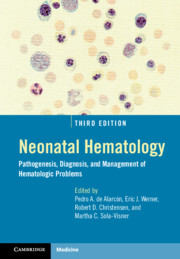Book contents
- Neonatal Hematology
- Neonatal Hematology
- Copyright page
- Contents
- Foreword
- Preface
- Contributors
- Section I Developmental Hematology
- Section II Bone Marrow Failure and Immune Disorders
- Section III Erythrocyte Disorders
- Section IV Platelet Disorders
- Section V Leucocyte Disorders
- Section VI Hemostatic Disorders
- Section VII Neonatal Transfusion Medicine
- Section VIII Neonatal Oncology
- Section IX Miscellaneous
- Index
- Plate Section (PDF Only)
- References
Section VIII - Neonatal Oncology
Published online by Cambridge University Press: 30 January 2021
- Neonatal Hematology
- Neonatal Hematology
- Copyright page
- Contents
- Foreword
- Preface
- Contributors
- Section I Developmental Hematology
- Section II Bone Marrow Failure and Immune Disorders
- Section III Erythrocyte Disorders
- Section IV Platelet Disorders
- Section V Leucocyte Disorders
- Section VI Hemostatic Disorders
- Section VII Neonatal Transfusion Medicine
- Section VIII Neonatal Oncology
- Section IX Miscellaneous
- Index
- Plate Section (PDF Only)
- References
Summary
Leukemia in the neonatal period is very rare and can present as early as the day of birth [1, 2]. Acute leukemia arises from clonal changes in hematopoietic precursor cells. In neonatal leukemia, defined as leukemia presenting in the first month after birth, these clonal abnormalities initiate during fetal development [3]. A backtracking molecular study of infants and young children who developed leukemia beyond the neonatal period demonstrated that the same clonal mutations found in the leukemia were also present in neonatal blood spots [4]. Though some epidemiologic studies have suggested that maternal intake of certain foods may contribute, the genetic and environmental risk factors for infant leukemia are not well understood [5–7]. One exception is the observation that an identical twin of an infant with acute lymphoblastic leukemia has a nearly 100% chance of developing the same type of leukemia [8, 9]. In contrast, the genetic risk factors associated with myeloproliferative neoplasms among neonates are better defined [10]. Neonates with Down syndrome are at risk of transient myeloproliferative disorder (TMD) [11) and neonates with Noonan syndrome or related Ras pathway disorders may present with juvenile myelomonocytic leukemia (JMML) [10]. Both TMD and JMML have the potential to be serious and life-threatening. Recognition of the presenting features of neonatal leukemia is important, as early initiation of therapy may prevent rapid progression of disease.
- Type
- Chapter
- Information
- Neonatal HematologyPathogenesis, Diagnosis, and Management of Hematologic Problems, pp. 367 - 400Publisher: Cambridge University PressPrint publication year: 2021



